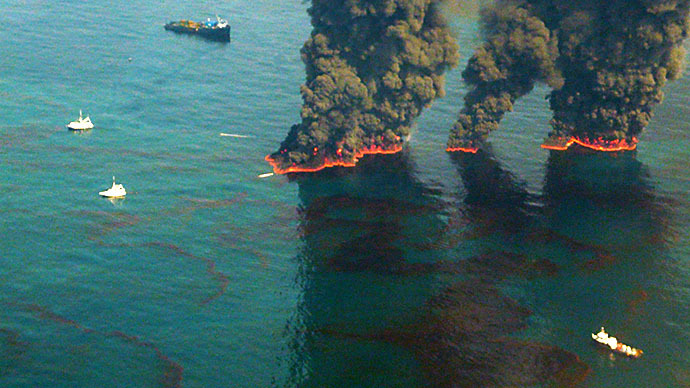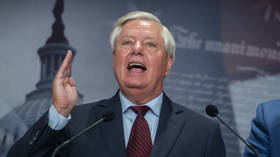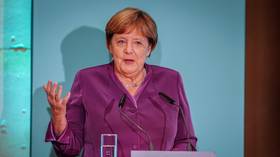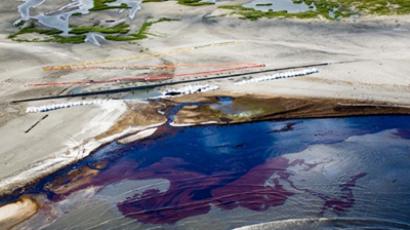BP accused of misleading govt during Gulf oil spill

Energy giant BP lied to the US government and withheld information about how much oil was spilling into the Gulf of Mexico in 2010 when one of its wells blew out ahead of the Deepwater Horizon rig explosion, government attorneys said Monday.
Lawyers for BP denied the accusations during opening statements
of the second phase of the trial over the spill, saying the blowout one mile below the
sea floor was too unique to adequately prepare for in advance.
Questioning BP’s efforts to cap the spewing well, which took
nearly three months, was “Monday morning quarterbacking at its
worst," BP attorney Mike Brock said, as quoted by AP.
The current phase of the trial focuses on BP’s response to the
spill. US District Judge Carl Barbier will ultimately determine
how much oil BP was responsible for leaking. The first phase of
the trial was dedicated to the cause of the well rupture.
US Justice Department experts estimate that 4.2 million barrels,
or 176 million gallons, spilled into the Gulf as a result of the
blowout. BP is urging Barbier to consider that 2.45 million
barrels, or nearly 103 million gallons, leaked into the ocean as
he assesses Clean Water Act fines for the company. The sides have
agreed that 810,000 barrels, or 34 million gallons, were captured
before polluting the Gulf.
An attorney for residents and businesses seeking damage from the
leak said that BP was not adequately prepared in the event of a
spill, nor was it forthright with US officials once the rupture
occurred.
"BP's plan was nothing more than a plan to plan," attorney
Brian Barr said of BP’s 600-page spill response guide, which only
included one page on “source control,” which called for
experts to be assembled to devise a plan in the wake of a
blowout.
BP said the preparations were in compliance with federal
government requirements and industry standards, and that the leak
caused damages the company did not foresee.
On April 20, 2010, BP’s Macondo well – located 50 miles off the
Louisiana coast - ruptured, causing an explosion on the Deepwater
Horizon drilling rig that killed 11 workers and became the worst
offshore oil spill in US history.
BP sealed the well on July 15, 2010, using a capping stack after
other attempts failed.
In May 2010, BP tried a “top kill” method of stopping the
oil, pumping mud and other materials into the well area. Lawyers
for the plaintiffs say BP knew the method would fail based on
higher flow rate projections that the company was not sharing
with the government at the time.
Former US Department of Energy Secretary Steven Chu said in
videotaped testimony shown in court Monday that BP did not
provide him certain data relevant to properly evaluating the
effectiveness of the “top kill” strategy.
"If one knew earlier the amount of flow, things would have
been different," Chu said.
Top BP official Doug Suttles told Coast Guard Rear Adm. Mary
Landry a week after the spill started that the company estimated
that 1,000 to 5,000 barrels of oil per day leaked from the well.
Yet detractors at the trial say BP internal documents and
communique show an effort to hide higher numbers.
"BP's policy of not releasing the flow-rate information was
enforced at the highest levels of the company," said Brad
Brian, an attorney for rig owner Transocean, pointing to an email
from a BP employee to BP Exploration and Production CEO Andy
Inglis and his assistant in mid-May.
The employee told them that his team’s models showed an estimate
up to 20 times higher, and that they should be “very
cautious” with the lower number.
The employee, Mike Mason, was called in for a meeting the next
day with Inglis’ assistant who told him he should not have made
the claim in writing. When Mason asked why, the assistant said,
"It's the big number," Mason recalled in video testimony.
Other methods BP used unsuccessfully included the Cofferdam and
the “top hat.”
BP maintains there was no way to prepare for such a spill of that
magnitude, though Barr said the company ignored repeated warnings
about possible deep-water ruptures.
"BP refused to spend any time or money preparing to stop a
deep-water blowout at its source," he said.
BP’s Brock countered, saying the company could not have stopped
the spill sooner if it had a pre-built capping stack. Such a
device had never been used by industry before, he said.
"It was a unique situation," he said. "It was a unique
blowout."
Polluters can be forced to pay a maximum fine of either US$1,100
or $4,300 per barrel of spilled oil, depending on how negligent a
company is found to have been. Using government spill estimates,
a maximum penalty for BP would be around $18 billion. Using the
company’s numbers, the maximum would be about $10.5 billion.
Clean Water Act penalties are such that 80 percent of BP’s fine
must be divided among the Gulf Coast states affected by the
spill.
The company has $42 billion reserved for paying fines and damage
claims associated with the spill.
Arguments in this phase of the trial will happen over the next
four weeks. A penalty phase has not been scheduled yet.














